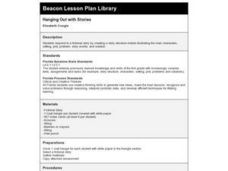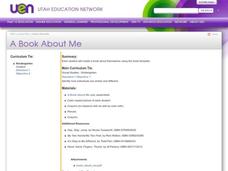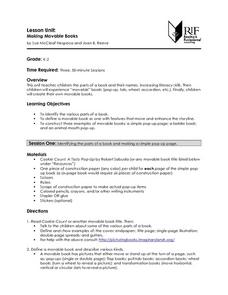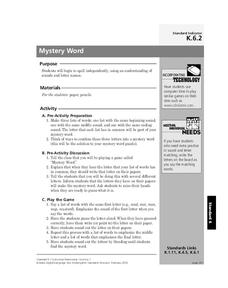British Council
Alphabet
Here's a packet filled with suggestions and activities for teaching the alphabet.
Houghton Mifflin Harcourt
Let’s Count!: Extra Support Lessons (Theme 5)
In a themed series of lessons and activities, beginner readers are given extra support in reading through chants, games, and practice worksheets.
Seussville
The Lorax's Earth Day
Add a touch of Dr. Seuss whimsy to your Earth Day celebration with six pages consisting of Earth-friendly, inspiring, and engaging activities designed to enhance the beauty of your school campus and showcase the famous story, The Lorax.
PBS
Reading Adventure Pack: The Lorax
Accompany a reading of The Lorax by Dr. Seuss and Tell Me, Tree by Gail Gibbons with an activity packet designed to bring awareness to nature, specifically trees. Scholars take to the outside, draw lines to create trees reminiscent of...
Newspaper Association of America
Cereal Bowl Science and Other Investigations with the Newspaper
What do cereal, fog, and space shuttles have to do with newspapers? A collection of science investigations encourage critical thinking using connections to the various parts of the newspaper. Activities range from building origami seed...
Curated OER
Visualarticulation
Use photographs to teach young special education or speech students how good speech looks, as well as sounds. Kindergarteners are photographed making the F, TH, W, R L, and S sounds. They then use the images to identify each sound that...
Curated OER
Predict and Clarify with The Old Woman & Her Pig
Primary readers predict and check for understanding by using comprehension strategies. Prepare readers the first day by frontloading vocabulary and using pictures to visualize the words. On the second day, read the story The Old Woman...
Curated OER
Hanging Out with Stories
Help your class listen and respond to a fictional story by creating a story structure mobile illustrating the main characters, setting, plot, problem, story events, and solution. Using a coat hanger, they will create an artistic element...
Curated OER
A Book About Me
How big is your foot? How long is your arm? How big is your mom’s hand? After learning how to measure body parts, young writers collect their observations into an illustrated book. Instructions for crafting a 3D Tim Foil Man are also...
Curated OER
My Community Book
Young learners examine different places in their neighborhood using informational texts. First they identify a place that they like to play and predict if it will be in the nonfiction book Community at Play.They will share their favorite...
Curated OER
Making Movable Books
Investigate the parts of a book and in particular, the pop-up, tab, wheel, and or accordion features that can be added to a book to move and enhance the storyline. This is a three lesson unit.
Curated OER
Spelling Relay
Looking for a way to review and practice spelling words that's fun and creative? Use this spelling relay activity for any grade level. Using three spelling lists, ranging in difficulty, teams of young spellers choose words from the lists...
Curated OER
I Pledge Allegiance
What does showing respect look like? What behaviors show disrespect? After modeling such behaviors, primary graders create a flag that they hold up while demonstrating respectful behavior as they recite the Pledge of Allegiance. The...
Curated OER
Blending Best Buddies
Practice blending letters together to make the words learners are reading. They decode words familiarized with the concept of blending. This lesson plan utilizes the Body-Coda method of blending developed by Lloyd Eldredge. Each child...
Curated OER
Dance: Water Dancing
Examine the way water moves, drips, and splashes with an expressive dance. Learners discuss the ways in which water moves, then create dance sequences that show or describe water. There are several suggestions to adapt this instructional...
Curated OER
Responding to Literature
Your class will create a four section flip book and write titles for characters, setting, problem, and solution. They will also draw a picture to show what they wrote about.
Curated OER
A House for Hermit Crab
Make predictions and recall details while reading A House For Hermit Crab. While you read the story, discuss aspects of the plot and encourage listeners to respond. Extension activities such as crafts, counting, puppets, and using your...
Curated OER
Sequencing The Mitten
Practice sequencing as a comprehension strategy. Have your class listen to The Mitten by Jan Brett and participate in guided practice with sequencing events. Then divide everyone into three groups based on understanding for independent...
Curated OER
Bright Mice
Kindergarten through second graders explore the long i sound. In this phonics lesson, they read The Mother's Day Mice, sing "Farmer in the Dell," and play I Spy with long i in order to explore the target sound. Additionally, there is a...
Curated OER
Guided Reading: Asking Questions
Here is a reading strategies lesson in which learners use post it notes to create a bulletin board. They post their new questions on the bulletin board and look back at questions they have already learned the answer to. A great idea,...
Curated OER
The Beginning, The Middle, & The End
Cut magazine pictures into three sections, having your youngsters piece the pictures back together. With this fun activity, they discover the importance of sequencing a story. Then they use a fun template (shaped like a burger) to write...
Curated OER
The Three Little Pigs
Kindergarteners are presented with three types of materials: real straw, sticks, and a real brick and make prior knowledge connections as it relates to the story of The Three Little Pigs. They listen to the story and work together to...
Curated OER
Mystery Word
Help spellers hear words that have the same beginning letter in them and guess the letter. Each speller has a piece of paper where they are to write down the letter once they have identified it. For instance, the teacher will say, "may,...
Curated OER
Tracing Capital Letters I-P
Practice capital letters I-P in this printing drill activity, which has young writers examine arrows on sample letters to guide their pencils. A shaded letter gives them tracing practice, and then they try a few on their own in the space...

























